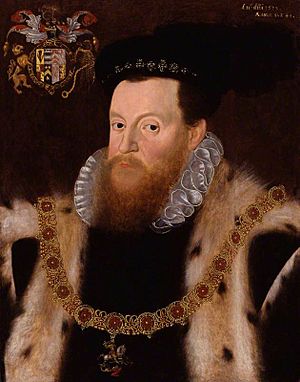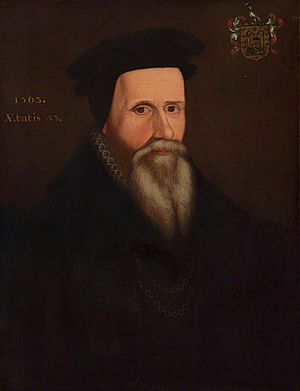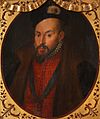Council of Wales and the Marches facts for kids
Quick facts for kids Council of Wales and the Marches |
|
|---|---|
| History | |
| Founded | 13th Century |
| Disbanded | 25 July 1689 |
| Leadership | |
|
President
|
Charles Gerard, 1st Earl of Macclesfield (final)
|
|
Vice President
|
Gervase Babington (final)
|
The Council of Wales and the Marches (which in Welsh is Cyngor Cymru a'r Gororau) was an important group that helped govern parts of Wales and the areas next to it, called the Welsh Marches. It was first set up in Shrewsbury.
This council was active for a long time, from the 1400s to the 1600s. Its main offices were at Ludlow Castle and near Shrewsbury Castle in England. The council had many different jobs. It handled everything from solving legal problems to looking after public health and managing the government of the area.
The area the council was in charge of changed over time. But it usually covered all of modern Wales and the nearby English areas known as the Welsh Marches. These included parts of Shropshire, Herefordshire, Worcestershire, Cheshire, and Gloucestershire. However, the City of Bristol was removed from its control in 1562, and Cheshire in 1569.
The Council of Wales and the Marches was quite similar to another group called the Council of the North. Today, the old records and documents from the council are kept in Shrewsbury.
Contents
History of the Council
Starting in the 1400s
The council's first job was to manage the lands that were part of the Principality of Wales. These were lands directly controlled by the English King after Edward I conquered Wales in the 1200s.
In 1457, King Henry VI created a council for his son, Prince Edward. This council was meant to rule Wales, the Marches, Cheshire, and Cornwall.
Later, King Edward IV brought the council back. He wanted it to advise and act for his young son, Edward, Prince of Wales. King Edward IV had just won back his throne during the Wars of the Roses. He and his friends controlled most of the important areas in and around Wales. He set up his son at Ludlow Castle. He also appointed his allies, like the Woodville and Stanley families, to lead the council.
Growing in the 1500s
The council continued to operate even after King Edward IV died and his sons, the Princes in the Tower, disappeared. Under King Henry VII, the council worked for his sons as they became Princes of Wales. First, it was for Arthur, Prince of Wales, and then for Henry VIII.
In 1542, a law called the second Laws in Wales Act officially recognized the council. Before this, its power came only from the king's personal authority. The full council included a main leader (called the lord president), a deputy, and twenty members chosen by the king. These members included people from the royal family, some Welsh bishops, and judges.
The council continued to meet at Ludlow. It was responsible for all of Wales and the Welsh Marches. These Marches were first thought to include Cheshire, Shropshire, Herefordshire, Worcestershire, and Gloucestershire. But as mentioned, Bristol was removed in 1562, and Cheshire in 1569.
Worcestershire tried to leave the council's control in 1576 but failed. The council's power over the English counties was reduced in 1606. However, the king brought it back fully in 1609.
Important people who served on the council included Sir Rowland Hill and Sir Henry Sidney. Sir Henry Sidney was the president of the council from 1560 to 1586.
A historian named John Davies said that when the council was at its best, especially under Sidney, it was "a remarkable experiment in regional government." He noted that it handled legal cases quickly and cheaply. It could deal with up to twenty cases a day. People who were poor and felt unfairly treated often came to the council for help.
What the Council Did
The law that officially recognized the council didn't list all its jobs. It just said the president and council could handle "such Causes and Matters as be or heretofore hath been accustomed and used." But the council's jobs were seen as very broad.
Here are some of the things it did:
- It heard all kinds of lawsuits, both civil (about disagreements between people) and criminal (about crimes). It helped people who were too poor to go to regular courts.
- It tried cases of murder, serious crimes, piracy (sea robbery), and other crimes that could disturb the peace.
- It looked into charges of bad behavior by officials and unfair decisions by juries.
- It made sure laws against certain old practices, like "livery and maintenance" (where powerful people illegally supported others in legal disputes), were followed.
- It punished people who spread rumors or were unfaithful.
- It dealt with arguments about land enclosures (fencing off common land), old forms of forced labor, and village issues.
- It heard appeals from other courts.
- It was in charge of making sure laws about religion were followed.
The council also played a role in public health. For example, in 1551, when a serious illness called "sweating sickness" broke out in Shrewsbury, the council was in charge of the response. They even appointed a doctor, Dr John Caius, to help the sick.
Ending in the 1600s
The Council of Wales and the Marches was officially closed down on July 25, 1689. This happened after the Glorious Revolution of 1688. That revolution removed King James II from power and brought William III and Mary II to the throne.
According to historian John Davies, when the council at Ludlow was abolished, there wasn't much protest in Wales. Instead, the wealthy Welsh families started to look more towards London for their future.
Leaders of the Council
The following people served as the main leaders, called presidents, of the council:
- 1473–1500: Bishop John Alcock
- c. 1501–1512: Bishop William Smyth
- 1512–1525: Bishop Geoffrey Blyth
- 1525–1534: Bishop John Vesey
- 1534–1543: Bishop Rowland Lee
- 1543–1549: Bishop Richard Sampson
- 1549–1550: John Dudley, Earl of Warwick
- 1550–1553: William Herbert, 1st Earl of Pembroke
- 1553–1555: Bishop Nicholas Heath
- 1555–1558: William Herbert, 1st Earl of Pembroke
- 1558–1559: Bishop Gilbert Bourne
- 1559: John Williams, 1st Baron Williams de Thame
- 1560–1586: Sir Henry Sidney
- 1586–1601: Henry Herbert, 2nd Earl of Pembroke
- 1601 (acting?): Sir Richard Lewknor
- 1602–1607: Edward la Zouche, 11th Baron Zouche
- 1607–1616: Ralph Eure, 3rd Baron Eure
- 1616–1617: Thomas Gerard, 1st Baron Gerard
- 1617–1630: William Compton, 1st Earl of Northampton
- 1631–1642: John Egerton, 1st Earl of Bridgewater
- 1660–1672: Richard Vaughan, 2nd Earl of Carbery
- 1672–1689: Henry Somerset, 1st Duke of Beaufort
- 1689: Charles Gerard, 1st Earl of Macclesfield
Vice-Presidents of the Council
The following people served as vice-presidents of the council:
- 1550–1551: Sir James Croft
- 1559: Hugh Paulet
- 1562–1576: Sir William Gerard
- 1565–1569: John Throckmorton
- 1569–1571: Sir Hugh Cholmondeley
- 1575–1577: Andrew Corbet
- 1577–1580: Bishop John Whitgift
- 1605–?: Gervase Babington
Also, from 1542, the Justice of Chester (and later the Chief Justice of Chester) often acted like a vice-president, even if they didn't officially have the title.
Images for kids
See also








